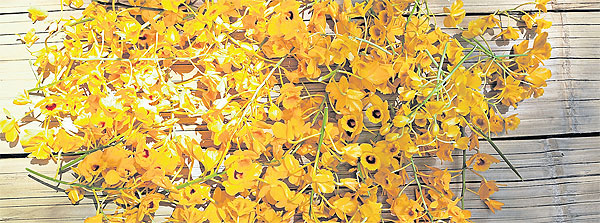Hailed as a green hero, the late Joseph Margraf was recognised for his reforestation initiatives. Based in China, the German biologist founded the Tianzi Exploratory Nature Reserve in the mountains of Yunnan and it was there that he discovered the endangered orchid Vanda coerulea and replanted specimens of Dendrobium chrysotoxum, sometimes called the "gold orchid", while saving this section of rainforest and its biodiversity.

Scientific research on both species identified molecules for cosmetic purposes and extracts from these orchids are now components in Imperial Orchid Molecular Extract, a key ingredient in Guerlain's Orchidee Imperiale skincare range.
"With a diversity of over 30,000 species, orchids have an exceptional ability to thrive at different altitudes and adapt to hostile environments and terrible conditions. The orchid is also an impressive model of plant longevity as it is capable of living for over 100 years. This holds many possibilities for scientific research in unlocking its secret to longevity," said Guerlain's skincare manager, Anne-Sophie Sauvage.
Guerlain's research project involves the Tianzi Exploratory Nature Reserve, an experimental garden in Switzerland and a research lab in Strasbourg.
"Other cosmetic companies have to source for active ingredients. Guerlain is the only brand with research centres dedicated to only one plant, and the ongoing research will involve more species," Sauvage said of the investment in orchidarium reserach, which has been running for more than 12 years.
A unique collection of wild orchids are grown in a greenhouse at the Swiss experimental garden whereas orchids are cultivated naturally in the wild, according to "jungle farming" principles at the Tianzi reserve, now headed by Joseph Margraf's wife, Minguo Li.
A former journalist with a background in classical Chinese literature, Li has become an expert on orchids.
"As I was his student for 10 years, he was like my mentor. Also, because of him, I became a wife and a gardener," she said of her late husband. The dedicated gardener employs jungle farming methods in a tropical reforestation programme that aims to protect both the biodiversity of the area and precious orchid species.
"There are many more orchids to discover, but if the forest disappears the orchids will disappear too," said Li. "Human beings are the biggest threat to nature with the expansion of rubber plantations as well as residential and commercial developments coming closer to the mountains."
Dendrobium chrysotoxum, the gold orchid, grows at altitudes of between 400m and 1,800m and is found along the borders of China, Thailand, Myanmar, northern India and Nepal. Its resilience comes from having tough and waxy leaves, watertight bulbs and roots which are delicate yet strong enough to anchor it in the treetops between 4m and 20m above ground level.
Raising the gold orchid at its own pace requires patience as one has to wait for seven years for a young plant to reach maturity. The flowering period lasts for two to three weeks in April when harvesting of the golden-yellow flowers can take place. The flowers then undergo treatment in a solar dryer for two to three weeks during which time they soak up water in order to survive as if they were enduring a prolonged period of drought. Extraction then brings out active molecules for use in cosmetic formulation.
Guerlain also did research on another orchid species called Vanda teres found in the canopy of tall trees in the Himalayan foothills. Boasting pale pink flowers, this resilient species thrives in areas exposed to sunlight.
"In natural circumstances, the orchid is much more active than when grown in a greenhouse. It actually becomes stronger when attacked or when it comes under stress in the wild, and we are interested in the vital energy that gives the orchid its resilience. Research has been directed towards transferring this energy to benefit the skin," Sauvage said.
According to Guerlain's research into cellular bioenergetics, progenitor or mother cells are responsible for cell fertility, which is a crucial process to ensure the continual construction of multi-layered skin. The construction process depends on the vital energy of mother cells and a decreasing energy supply affects cell longevity, thus contributing to skin ageing.
The French beauty house aims to transmit the orchid's energy to human skin via the aforementioned Imperial Orchid Molecular Extract, now into its third generation and featuring extracts of Dendrobium chrysotoxum as well as Vanda coerulea and Vanda teres.
Guerlain first incorporated orchid extracts into its Orchidee Imperiale Cream launched in 2006. A complementing eye and lip cream will be introduced to the Thai public this Friday.
"The freshness of the eyes and smile affects the youthfulness of the face," said Sauvage. "However, the skin around the eyes and lip contour is constantly subject to environmental aggression. The low number of sebaceous glands and absence of a protective hydrolipid film make it vulnerable to attack from the sun, heat, cold and dry atmospheres. With facial expressions, it must also withstand thousands of tiny movements pulling on the skin each time."
With a silky light texture, the Orchidee Imperiale eye and lip cream also contains blackberry leaf, Centella asiatica, liquorice root and yeast extracts to address multiple problems such as puffiness and dark circles.
"The eye and lip contour compares to orchid petals, which appear fragile yet are strong," Sauvage said. "This inspires us to answer women's needs in boosting the resilience of this delicate area with the new product."


Hand-harvesting of the gold orchid blooms takes place in April.

Dendrobium chrysotoxum , aka gold orchid, is sometimes described as ‘‘the golden seed from the tree of life’’.

Orchidee Imperiale face cream and the new eye and lip cream.

